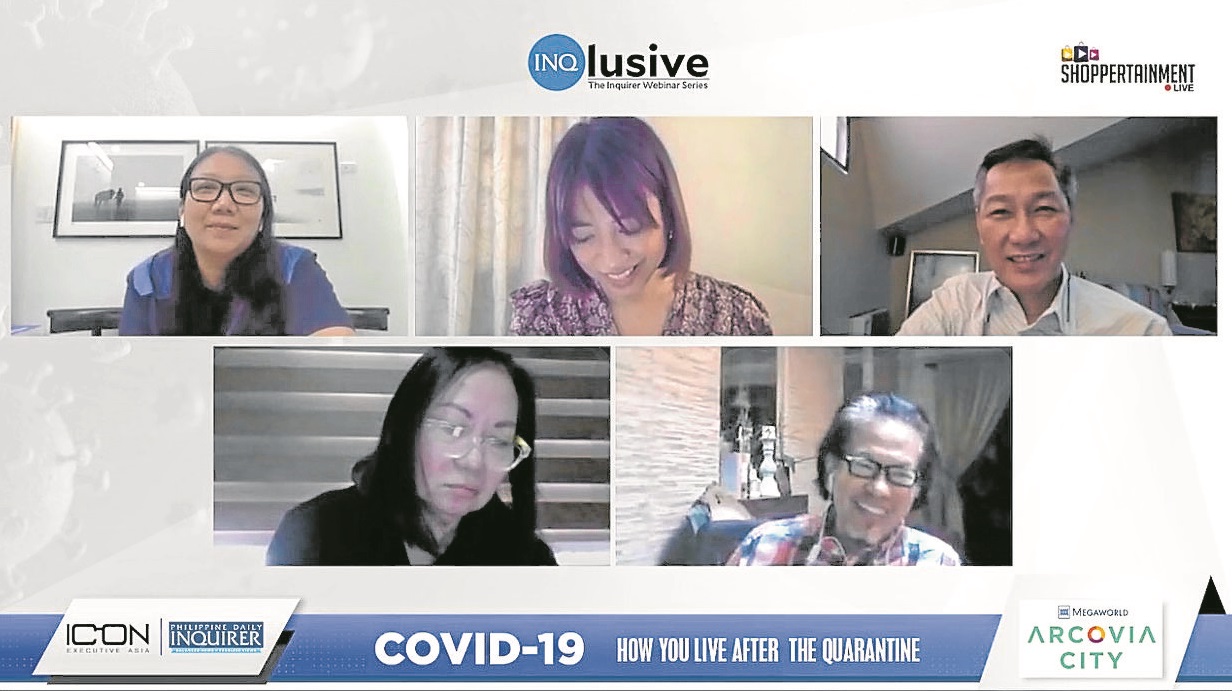
A deadly infection the world had never seen breaks out, and life as we once knew it disappears. To survive, we impose self-isolation and wear protective gear. We adapt, or we die.
Last May 12, Inquirer Lifestyle held its first webinar on Facebook Live, “COVID 19: How You Live After the Quarantine,” and peaked close to 100,000 viewers. The nearly two-hour webinar generated more than 1,500 comments and questions from viewers, most wanting to know how to survive the coming months.
So, what does Charles Darwin’s theory of “survival of the fittest” mean in the time of the pandemic?
One of the webinar’s guest speakers, Lifestyle columnist Dr. Rafael Castillo, a cardiologist, said that without any treatment options, our survival would depend entirely on our immune response.
Other guest speakers were Dr. Gwen Dy Agra, director of the Institute of Pulmonary Medicine, St. Luke’s Medical Center, Bonifacio Global City, and Dr. Robbie Meriales, orthopedic surgeon and new coronavirus disease (COVID-19) survivor. The webinar was hosted by Patt Soyao of Icon Executive Search, and moderated by Lifestyle editor Thelma San Juan and assistant editor Cheche Moral.
“The viral infection is not severe. The problem is how the body reacts to the virus. Sobrang pamamaga ng lahat ng parte ng katawan, and that can include the arteries, blood vessels,” Castillo said.
The irony, Castillo pointed out, is that with prolonged quarantine, we unwittingly weaken our immune system.
“The government is overzealous in keeping us inside our house. You can’t even go out to get some sunshine. Sunlight is one of the most economical forms and most effective of treatments against COVID-19,” he said.
Exposure to sunlight triggers the production of vitamin D, which is important to innate immunity and boosts immune function against viral diseases. Expose yourself to sunlight 15-20 minutes each day, Castillo said, either early in the morning or late in the afternoon. Or, you can stagger exposure throughout the day.
Rhythm
“Eat well, eat properly,” said Meriales, who spent a week in ICU when he battled COVID-19. “Nutrition is still the key. Try to get back into your rhythm. If you’ve been afflicted, slowly get back into your rhythm. Do not baby this thing. Your body will not get better if you lie around all day. Get your heart moving and your lungs expanding. Do some physical activity.”
However, Castillo said that living in small quarters also dissuades people from working out. “That is the downside to prolonging the lockdown.”
Agra suggested regular intake of vitamins C and D for anyone not getting enough sunlight. Castillo said melatonin supplements are among the unrecognized best supplements to boost the immune system.
“We don’t know our enemy completely, so we have to reduce the amount of transmission. Community transmission is the enemy and we need to address that,” Meriales said.
If and when enhanced community quarantine is lifted, the government must put in place mechanisms to ensure public safety. There must be strict protocols implemented in high-risk areas like NCR, Cebu City and some parts of Laguna.
“As for the lifting, it has to be calibrated. You can’t have just one policy for the entire country,” said Castillo. For example, only the workforce under 50 years old is allowed to go to work. Once at work, employees should not be allowed to eat together. It’s when coworkers start socializing at mealtime that transmission of the virus can happen, said Agra. Hand hygiene must be observed, temperature checked at each entrance and alcohol gels readily available in strategic places of the workplace.“Transportation is crucial since not everyone has a car,” Castillo said.
Companies must set different work schedules for everyone, he added. “Maybe some go to work at 6 a.m. and go home at 3 p.m. This way there won’t be peak traffic hours any more. Instead of five workdays per week, some could work a three-day workweek to avoid congestion in commuting. After a week, we review if this works.”
These guidelines must be announced a week before everyone returns to work.
“You also need a good picture of the enemy. How many are asymptomatic? Are we ready to let all these people out in public? If enough testing is done, we can limit the activities of these people,” Meriales said.
Sleep alone, eat alone
Meriales said that when you’re tested positive, it’s not just about quarantining yourself from your neighborhood, but quarantining from everyone in the house. “Sleep alone, eat alone, wear a mask when going out, stay away from your family for at least two weeks.”
Another concern raised by a viewer was the rate of infection. Do the survivors develop an immunity to the infection? Why are some survivors testing positive again?
So far, there is no evidence that people who have recovered from COVID-19 and have antibodies are protected from a second infection. So much is unknown about the virus, Agra said.
“The swab detects only the DNA of the virus. It doesn’t mean they have an active infection. If you have to be academic about it, we have to culture it to see if it will grow,” Agra said. “We don’t have a way of saying if it’s an active infection without cutting it.”
High-risk people include cancer patients, diabetics, those with chronic obstructive pulmonary disease, bronchial asthma, morbid obesity, heart conditions and hypertension.
Obese people have a body mass index of 30 and higher. The compliance of the lungs is restricted in the morbidly obese; lungs are constricted by fat and cannot expand as efficiently.
“Our lungs do not grow big when we get big. They maintain their original size. Most morbidly obese people also are not active, putting them at an even higher risk,” Agra said. INQ
“COVID 19: How You Live After the Quarantine” was presented by Inquirer Lifestyle, Icon Executive Search, Shoppertainment, inquirer.net, SM Supermalls and Megaworld Corp.